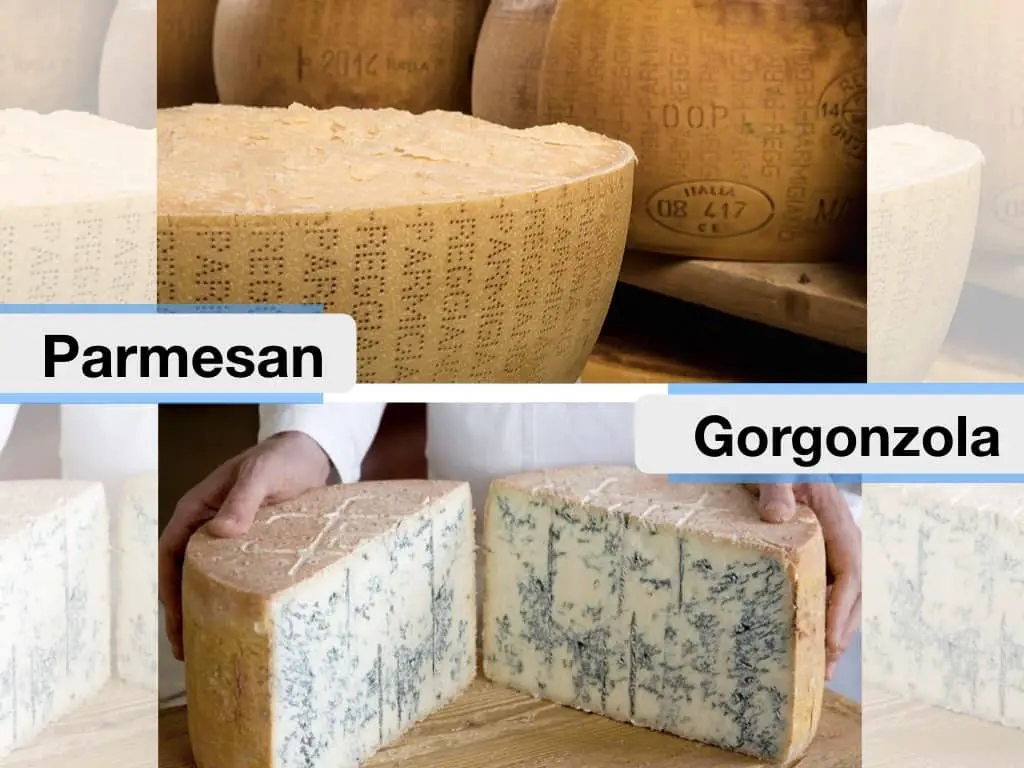Last Updated on November 5, 2022 by Aaron
Parmesan (commonly refer to Parmigiano Reggiano) and gorgonzola are both the Italian cheese that has a long history to trace. They are both certified PDO (Protected Designation of Origin) product regulated under the EU law, where the cheese can only be made in the restricted region in Italy.
Therefore, more often, there is a lot of “fake” imitation across the globe. So much so, these imitations have formed themselves a new industry that worth millions of dollars.
| Gorgonzola | Parmesan | |
| Origin | Gorgonzola town, Milan, Italy | Parma, Emilia Romagna, Italy. |
| Texture | Semi-soft, firm | Hard, firm, gritty |
| Taste | Buttery, sweet, nutty, sharp | Fruity/nutty, savory, umami, rich, bitter |
| Color | White, blue-green | Pale yellow, straw |
| Source of Milk | Cow milk | Italian Red Cow’s milk |
| Pasteurisation | Yes | No |
| Lactose concentration | <4 gram per 100g | 0-5 gram per 100g |
| Histamine level | ~150 mg/kg | Up to 2100 mg/kg |
| Aging Time | 2-3 months | 2-3 years |
| Calories | 357 kcal per 100g | 392 kcal per 100g |
| Price (per pound) | $12 (This one via Amazon) | $17 (This one via Amazon) |
Table of Contents
What was going on?
The parmesan cheese can be traced back to as early as the Middle Ages (5th-15 century), after the fall of the Roman Empire. It was the monk that lived in the Parma-Reggio region who started making this aged cheese, read more history.
Gorgonzola, on the other hand, was first produced in the 11th century in a small town named Gorgonzola in the province of Milan. According to the locals, it was a dairyman in Gorgonzola who first created a unique tasting cheese by accident, and soon after getting more and more popular.
Manufacturing and ingredients used
The cheesemaking process for parmesan and gorgonzola are quite different.
Parmesan uses the unpasteurized raw whole milk mixed with naturally skimmed milk. The animal rennet (Similar to Feta rennet as explained here) and starter whey were added during the process. For the curing stage, the cheese will normally be aged for 2-3 years. If you would like to learn more about the bacteria used, I have a list here for you.
For Gorgonzola, pasteurized whole milk is used to mix with animal rennet, starter culture (bacteria) and Penicillium
If you are vegetarians, I wrote an article about gorgonzola for vegetarian previously here.
How and when to use
The well-aged classic parmesan cheese will have a strong fruity and umami taste. Therefore it’s very popular to use in soup, pasta, crackers, macaroni, pie, pizza, and many popular dishes. I mean, who doesn’t like chicken parmesan?!
The aged gorgonzola (3-months or older) has a heavy buttery taste, also sweet and tangy. Therefore, it’s awesome to go with sandwich, pasta, or pizza. People often balanced the taste with other mild cheeses too.
Nutrition – which one is healthier?
| Gorgonzola (per 100g) | Parmesan (per 100g) | |
| Protein (g) | 25.0 | 35.8 |
| Fat (g) | 28.57 | 25.0 |
| Carbohydrate (g) | 3.57 | 3.2 |
| Sugar (g) | 3.57 | 0.11 |
| Calcium (mg) | 536 | 1184 |
| Sodium (mg) | 929 | 1175 |
| Iron (mg) | 0 | 0.82 |
| Vitamin A (IU) | 1071 | 781 |
| Vitamin B-12 (µg) | – | 1.2 |
| Vitamin C (mg) | 0 | 0 |
| Cholesterol (mg) | 89 | 68 |
The data (for gorgonzola and parmesan) obtained via the USDA Nutrient Database.
All cheese are healthy, but nutrition-wise, parmesan cheese is slightly better than the gorgonzola according to the data above.
Parmesan cheese showed a higher protein content, lower fat/cholesterol, and has double calcium value compared to gorgonzola.
See parmesan vs cheddar.
Histamin
Parmesan and gorgonzola are both having a considerable amount of histamine level. Given that 150 mg/kg (or 68 mg/lb) for Gorgonzola, and up to 2100 mg/kg (or 953 mg/lb) for parmesan depending on the aging duration. The FDA recommendation daily consumption for low histamine diet should be below 200 mg/kg and it should even be lesser for people with histamine intolerance.
That’s because of fermentated food will tend to have a higher histamine.
The long aging time and improper storing of cheese (e.g. fluctuate in temperature) may lead to increase histamine buildup due to the microbial activity. So, make sure your unfinished cheese is always properly stored and refrigerated. I have an article about how long the gorgonzola gone bad if left out.
Lactose and FODMAP
For people with IBS or lactose intolerance, here is the good news for you. For low lactose and low FODMAP diet, in general, parmesan and gorgonzola are both suitable to include.
You can learn more about gorgonzola FODMAP or this parmesan FODMAP in my other articles.

